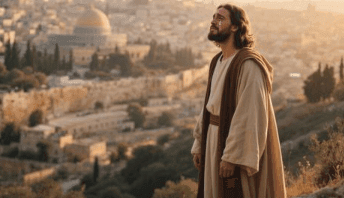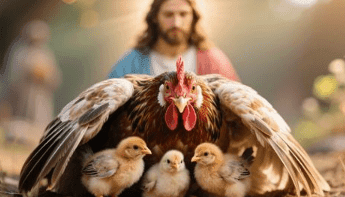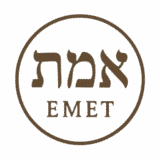The Cry of the King : A Mother’s Heart for Jerusalem’s Peace
When Jesus stood before Jerusalem and cried out, “O Jerusalem, Jerusalem, thou that killest the prophets, and stonest them which are sent unto thee, how often would I have gathered thy children together, even as a hen gathereth her chickens under her wings, and ye would not!” it was not simply a lament over a city. It was the cry of God’s heart, the grief of a Father with a mother’s compassion, the anguish of love rejected. To truly understand the depth of this moment, it helps us to step back into the Hebrew mindset, because behind the Greek text of Matthew’s Gospel lies the Hebrew thought, imagery, and letters that bring life to the words.

The name Jerusalem itself, in Hebrew Yerushalayim, is already a sermon in miniature. Its letters begin with Yod, the smallest of letters, a spark of God’s hand, followed by Resh, which speaks of authority or headship. Joined to this is Vav, a hook, the joining of heaven and earth, then Shin, the letter of fire and God’s refining presence. Lamed follows, the staff of teaching and authority, then again Yod, reminding us of God’s hand extended, and finally Mem, which is water, representing nations and hidden depths. When Jesus cried “Jerusalem, Jerusalem,” He was not merely speaking to a geographical location but to the city intended to be the dwelling place of peace, the place where heaven and earth meet, where God’s hand, authority, fire, and teaching would overflow into the nations. Yet the very city designed to join heaven to earth had rejected its divine calling. Its letters revealed its destiny, yet its actions revealed its rebellion.
Jesus then described Jerusalem as “the one killing the prophets.” In Hebrew this comes from the root harag, meaning to slay. The letters of this word are Hey, Resh, and Gimel. Hey speaks of breath and revelation, Resh of authority, and Gimel of pride or lifting. Spiritually this reveals a tragic reversal. What should have been a city breathing revelation, carrying divine authority, and lifting up God’s glory had instead turned pride into violence. The breath of God was choked, the authority of God resisted, and pride had risen so high that it chose to kill those who spoke in His name.
The word for prophets in Hebrew comes from the root nava, spelled Nun, Bet, Aleph. Nun represents life, seed, continuation. Bet represents the house or dwelling. Aleph is the strong leader, the symbol of God Himself. Thus, a prophet is one who brings the life of God into the house, one who declares the presence and authority of the Almighty. To kill the prophets, therefore, was not merely the rejection of men; it was the rejection of life itself, the rejection of God’s dwelling, the rejection of His authority. And Jerusalem, which was called to be the house of peace, had become the house of death.
Jesus also accused Jerusalem of stoning those sent to her. The Hebrew root saqal for stoning carries the letters Samekh, Qof, and Lamed. Samekh means support, a circle, a shelter. Qof represents holiness, cycles, and what is behind the head. Lamed again is teaching and authority. Stones were meant in Israel’s history to be reminders of covenant, markers of God’s faithfulness, altars of worship. Yet here they were turned into weapons against God’s messengers. What was designed for holiness and teaching had become tools of destruction. Instead of finding shelter in God’s covenant, they used covenant symbols to silence the very voices calling them back to it.
Then comes the heart of Jesus’ lament: “How often would I have gathered thy children.” The Hebrew word asaf for gather is built from Aleph, Samekh, and Pe. Aleph is God, the source; Samekh is support and shelter; Pe is the mouth, expression, or speech. Gathering, in God’s design, is God Himself providing shelter and speaking life over His people. It is a beautiful picture of intimacy, protection, and belonging. The children, banayikh in Hebrew, are from the root ben, meaning son or child. Bet and Nun spell house and life. Children are literally “the life of the house.” Jesus longed to gather the life of Jerusalem’s house, to preserve her future and nurture her destiny.

The picture He used was maternal and tender: “as a hen gathers her chicks under her wings.” In Hebrew, hen is tarnegolet, a word rich with covenant imagery. It begins with Tav, the sign of covenant, followed by Resh, head or authority, Nun for seed, Gimel for lifting, Vav for connection, Lamed for teaching, and Tav again for covenant. A hen symbolizes covenant protection and maternal care. Her wings, kanafim in Hebrew, come from the letters Kaf, Nun, and Pe. Kaf is the palm or covering hand, Nun again is life, and Pe is speech. Wings in Scripture always represent God’s protective covering, His open hand of life extended in blessing. Jesus was saying, “I have always been the covenant-keeping God, longing to cover you with My hand, to give you life, to speak My blessing over you.”
But then comes the tragedy in the final words: “and you would not.” The Hebrew root avah means to be willing. Its letters Aleph, Bet, and Hey speak of God as the source, the house as His dwelling, and Hey as revelation. To refuse God’s will is to reject God as the source of the house, to reject His revelation, to reject His presence. This was the deepest pain for Jesus: His people, the city called to be the house of peace, refused the covering wings of God.
Spiritually, this verse reveals the heart of Christ in His mission. He is not distant, cold, or indifferent. He longs, as a mother longs for her children, to gather us, to protect us, to keep us under the shadow of His wings. But love requires willingness on both sides. He will not force His covering; He invites, He calls, He cries, but He will not coerce. The rejection of His wings brings desolation, just as it did for Jerusalem.
Yet even here, hope lingers. The Hebrew imagery shows us that the God who longs to gather is still the same God today. The covenant is still offered. The wings are still spread wide. The cry of Jesus over Jerusalem is also His cry over every heart that resists Him. He sees the destiny, the beauty, the calling of every life, but He also sees the pride, the refusal, the rejection. His lament is not anger but brokenhearted love.
When we meditate on the Hebrew letters, we see that every stroke, every sound carries layers of meaning. Jerusalem’s name itself contains the promise of God’s hand, His fire, His teaching, His presence. The word gather shows us His heart to shelter and speak life. The wings remind us of His covering, His covenant, His care. But the refusal shows us the tragedy of free will misused.
This verse is more than history. It is a mirror. Each of us must ask: are we like Jerusalem, rejecting the prophets, silencing God’s voice, unwilling to come under His wings? Or are we willing to be gathered, sheltered, and spoken over by our Redeemer?
In Christ’s lament we see the collision of divine destiny and human resistance. Yet in His tears we also see the hope that remains for all who will say yes. For the wings are still open, the covenant is still offered, and the God who cried over Jerusalem still cries out for us today: “Come to Me, and I will give you rest.”
